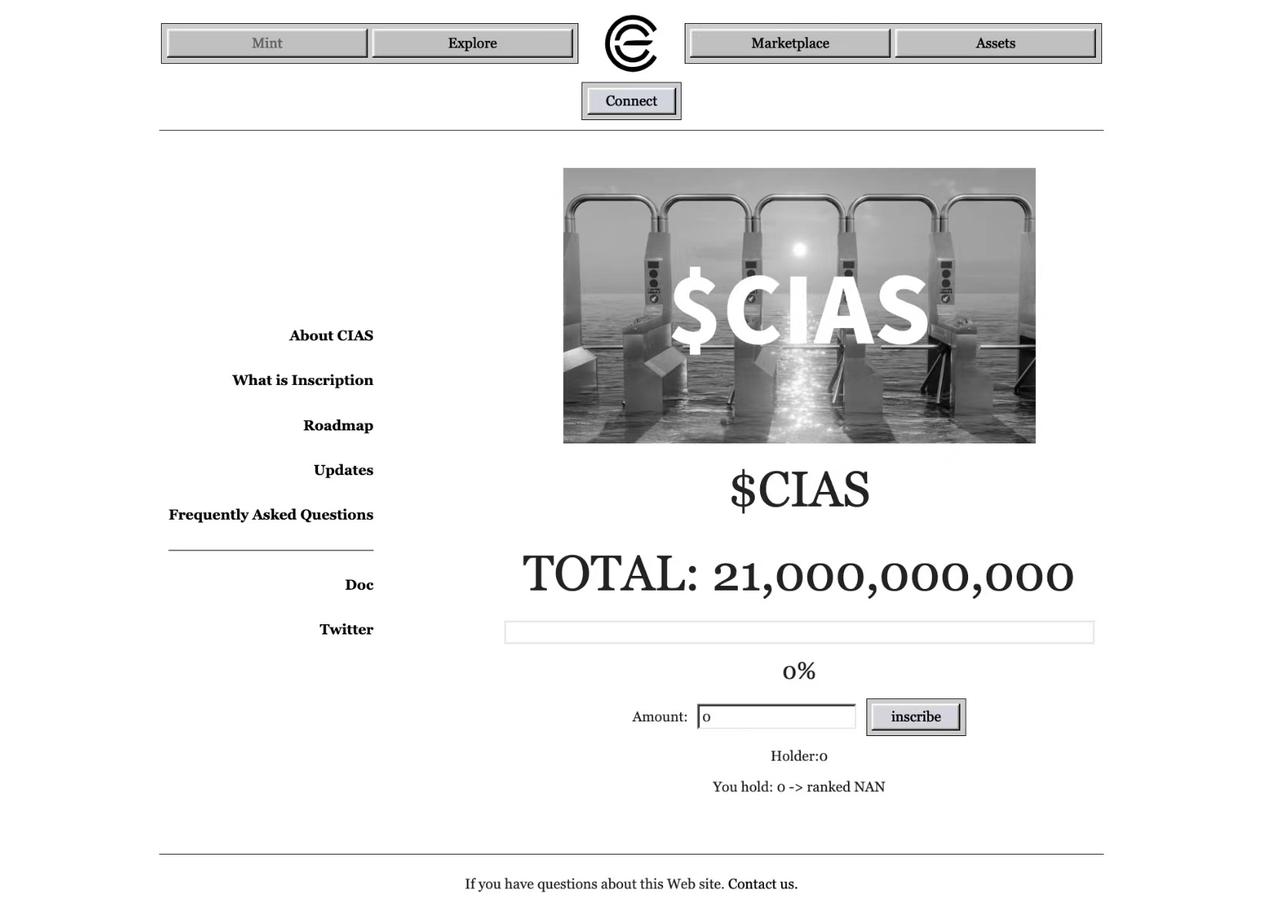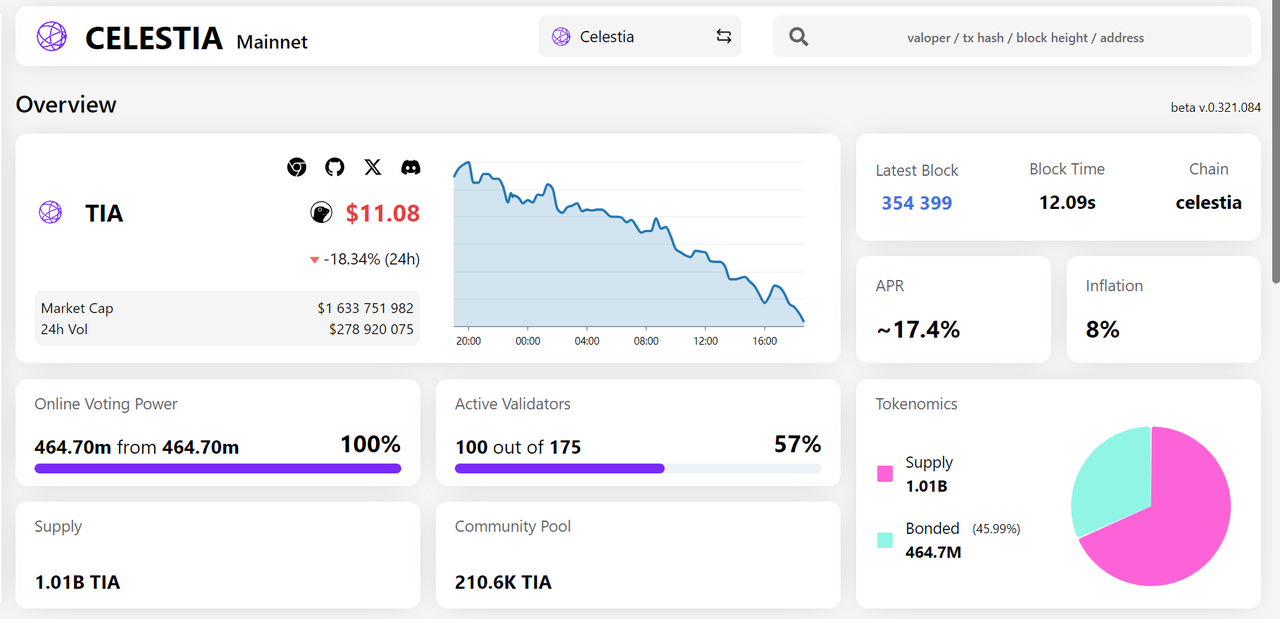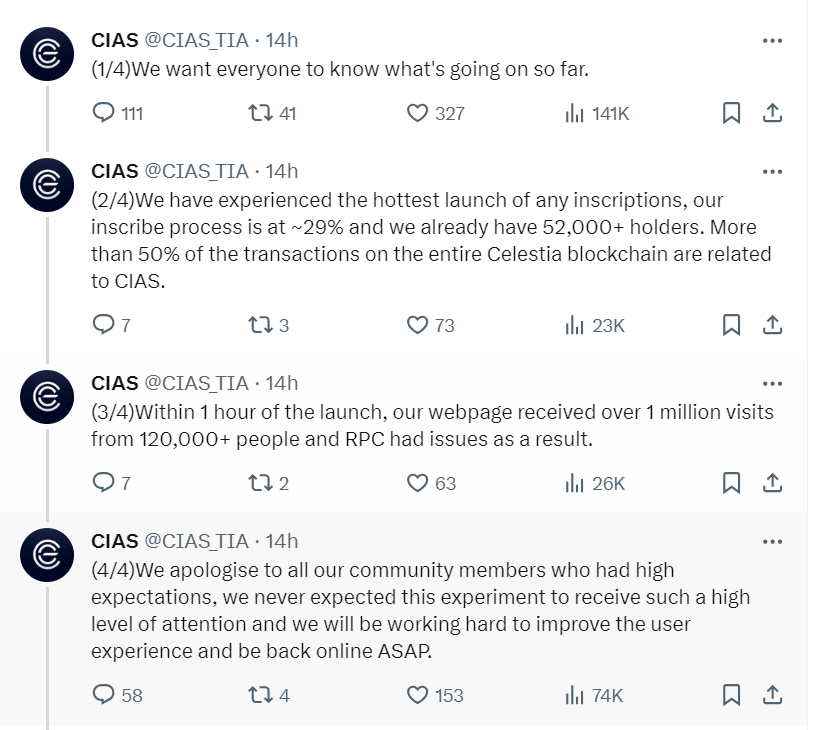0 The casting cost seems attractive, but the multiple vulnerabilities hidden in the Celestia inscription project CIAS are worth being cautious about
Author: DeMan
In an era where digital currencies and blockchain technology are becoming increasingly popular, the recent developments of the Celestia inscription project CIAS have sparked widespread attention on the X platform. CIAS announced that its minting process has reached approximately 29%, with over 52,000 holders. This figure is undoubtedly impressive on the surface. More notably, over 50% of the transactions on the Celestia chain are related to CIAS, indicating its significant influence within the Celestia ecosystem. However, as we delve deeper into these data, some critical questions arise.
Listing Key Issues of CIAS Recently, Discovering That the Project's Fundamentals Are Not as Optimistic as Imagined
First, the project attracted 120,000 visitors and over 1 million website visits within just one hour of its launch, leading to RPC failures due to the high traffic. Although the team promised to improve user experience and restore website functionality, this exposed the project's shortcomings in technical preparedness and scalability. In the digital currency space, user trust in the platform is crucial, and such technical failures could impact user confidence.

CIAS Official Website Page
Moreover, as the first inscription project on the Celestia chain, CIAS has a first-mover advantage in the market, but this does not guarantee its long-term stable development. In the blockchain industry, first-mover advantages often come with high risks, especially in a highly volatile market. Additionally, while CIAS has a clear roadmap and claims to be progressing as planned, this does not fully offset the risks posed by new technologies and market uncertainties.
Finally, CIAS's claimed "0 fee mint" strategy, while seemingly attractive, may hide other costs or risks. Without sufficient transparency and risk disclosure, this zero-cost strategy could mislead investors, especially inexperienced newcomers.
Overall, while the CIAS inscription project is active in the digital currency space, the underlying technical issues, market volatility risks, and transparency concerns warrant careful consideration.
The Inscription Project Has Extremely High Requirements for Immutable Transaction Records, Which Contradicts the Semi-Centralized Nature of Celestia
Celestia's modular blockchain technology, while theoretically showing foresight and innovation, reveals multiple issues when applied to inscription projects. The core of this technological architecture lies in its unique design, which decouples functions such as execution, settlement, consensus, and data availability across multiple dedicated layers, similar to a Lego structure. This brings flexibility and scalability to each module, but when applied to inscription projects, these advantages seem to turn into challenges.
The Celestia chain focuses on Data Availability Sampling (DAS) and Namespace Merkle Trees (NMT), and this data availability-centric design significantly conflicts with the inscription project's demand for data immutability. Inscription projects require the blockchain to maintain a high degree of data integrity and immutability, which the design of the Celestia chain may not be able to satisfy.

Celestia Network Data Chart
Furthermore, while the modular structure of the Celestia chain provides flexibility, it may also introduce complexity during the implementation of inscription projects. Inscription projects need a stable and consistent environment to ensure their reliability and efficiency, whereas the independence of various modules on the Celestia chain could introduce unnecessary complexity and potential compatibility issues.
Celestia's efforts to enhance chain scalability and performance may conflict with the inscription project's demands for immutable transactions and permanent historical record preservation. Particularly when handling a large volume of inscription transactions, this could pose challenges to the performance and stability of the Celestia chain.

Celestia Inscription Project CIAS: High Traffic Leading to RPC Failures
In terms of security and consensus mechanisms, the Celestia chain may also fail to fully meet the needs of inscription projects. Inscription projects have extremely high requirements for the security and attack resistance of the blockchain, while the design focus of the Celestia chain may lean more towards data availability and performance optimization.
The Inscription Market Is Beginning to Show Signs of Oversaturation, and Celestia May Follow in the Footsteps of Other Public Chains
On the Celestia chain, the rapid growth and proliferation of inscription projects are becoming a concerning issue. The root of this trend lies in the lack of standards and randomness in projects, which could not only lead to reduced liquidity in the secondary market but also trigger market volatility and instability.
The proliferation of inscription projects has resulted in a market flooded with numerous similar or low-quality products. This market saturation diminishes investor interest in these projects, especially when investors find it difficult to distinguish which projects are worth investing in. This uncertainty is detrimental to investor confidence, thereby affecting market liquidity and stability.
The lack of transparency and regulation further exacerbates this issue. In such an environment, the randomness and uncontrollability of inscription projects significantly increase the risks faced by investors. This risk is particularly pronounced for ordinary investors who are unfamiliar with the technologies and operational models behind these projects.
The excessive refinement of inscription project content on the Celestia chain also raises questions about its value and practicality. The oversaturation of overly segmented projects in the market has led to doubts about the uniqueness and appeal of each project, thereby impacting the overall market value. For example, the slowdown in the growth of the ordinals project on Bitcoin is a clear indication.
According to Dune data, the fees for Bitcoin Ordinals inscriptions dropped from $9.99 million on the previous day (17th) to $6.5 million, a decrease of nearly 35%. This not only reflects a decline in market interest in similar projects but also suggests that investors may be starting to hold skeptical views on the long-term value of such projects.
The proliferation of inscription projects not only reduces the effectiveness of investor choices but also increases uncertainty and risk in investments. Therefore, stricter and more systematic management and regulation of inscription projects are needed. To ensure the healthy and stable development of the market, measures must be taken to guarantee the quality and transparency of inscription projects, reducing market instability and potential risks for investors. At the same time, the market and regulatory bodies need to be more cautious and stringent in their application of these emerging technologies to prevent long-term negative impacts on the entire blockchain ecosystem.










